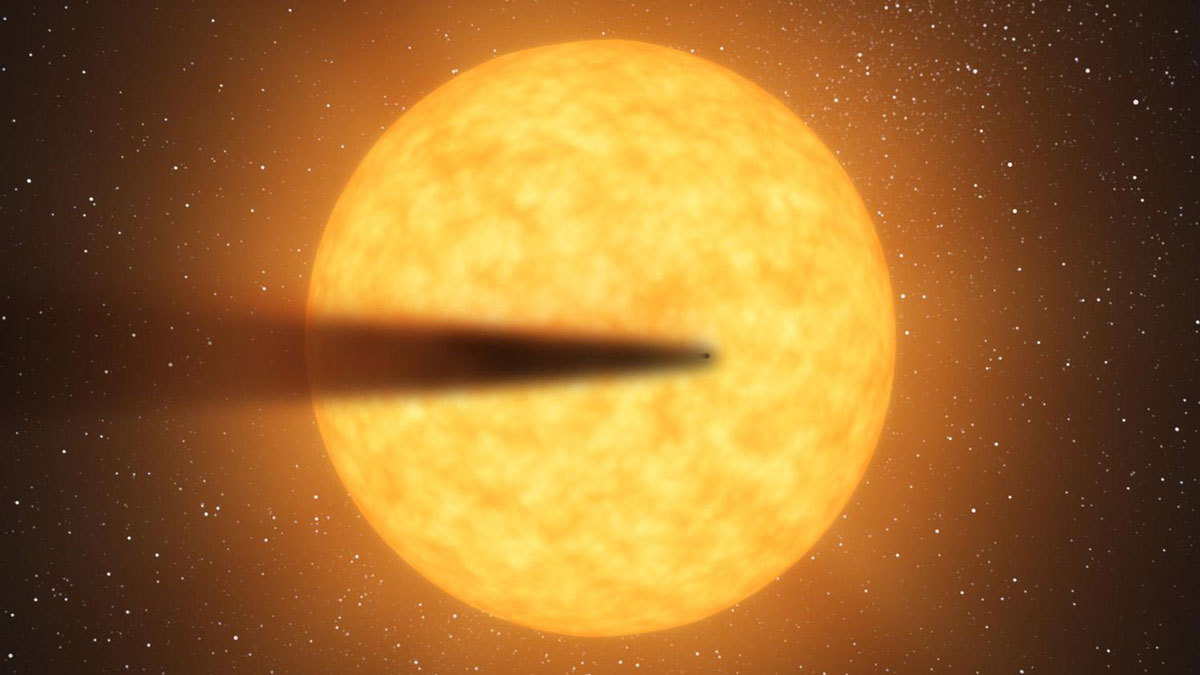Sometimes rocky planets get too close to their host stars for their own good. When this happens, extreme stellar irradiation can literally vaporize them. If their gravity is weak, the resulting gases escape into space, producing a comet-like trail made of chemicals that were once the planet’s crust, mantle, and core.
One such disintegrating planet, K2-22b, has been observed in detail for the first time with the James Webb Space Telescope (JWST), offering researchers a rare glimpse into the chemical composition of a rocky planet’s interior.
Discovered in 2015, K2-22b orbits a small star 787 light-years away, completing one orbit every 9 hours. Too small to be seen directly, K2-22b was detected because its star’s light was dimmed by the clouds of dust and gas that the planet periodically emits. Only four such planets have been discovered to date.
“Rocky planets tend to keep their insides on the inside,” said astronomer Nick Tusay from the Pennsylvania State University, who presented the results at a meeting of the American Astronomical Society. (The work has also been uploaded as a preprint while it undergoes peer review.) “These systems offer a unique opportunity for us to study their internal layers as they spew them out into space.”
“There’s likely still some meat left on the bone.”
JWST’s observations found no iron, a heavy metal typically found in the cores of rocky planets. This absence suggests the core remains intact. The telescope did, however, detect evidence of magnesium silicate minerals, indicating the mantle could be evaporating, although “there’s likely still some meat left on the bone,” Tusay said.
JWST also found hints of gases such as nitric oxide and carbon dioxide, typically associated with evaporating icy bodies. This finding puzzled the researchers because these components of ice should have disappeared long ago considering the high temperatures the planet is experiencing.
The spectroscopic results are “very surprising,” said University of Leeds astronomer Richard Booth, who wasn’t involved with the study. “We expected to see a composition akin to Earth’s mantle with minerals like magnesium silicate, and they see hints of that,” Booth said. “You just wouldn’t expect any icy material surviving at these temperatures.”
The authors speculated that the planet might have formed farther from the star than was previously thought and might have been pushed into a closer orbit by gravitational perturbations. Since K2-22b’s host star is part of a binary system, in which two stars orbit each other, such perturbations are to be expected.
Long-Anticipated Observations
Exoplanet researchers have anticipated these observations since the discovery of the first catastrophically evaporating exoplanet in 2012.
To analyze the remnants of K2-22b, researchers turned to a technique called transmission spectroscopy. Because different materials block and let through certain wavelengths of radiation, scientists can use a star’s light to determine the chemical makeup of the dust and gases swirling around it. It’s like a chemical fingerprint that is revealed by light.
The JWST is especially well suited for this task because the chemical signatures of rocks and minerals are visible only in infrared light, to which most other space telescopes (including the Hubble Space Telescope) are insensitive. Additionally, K2-22b’s M-type star is so faint that only an extremely large telescope like JWST, with its 6.5-meter primary mirror, can collect enough light to detect these signatures.
Even with JWST, Tusay and his colleagues ran into challenges observing K2-22b. Of four attempts to capture the planet crossing in front of the star, only one clearly succeeded. The group expects that future observation opportunities will yield more insights.
To determine K2-22b’s original makeup, researchers are now starting to reverse engineer the processes that turned the planet’s mantle to dust. JWST observed magnesium silicate, for instance, but that material likely underwent some major chemical changes since its time buried within the planet. Backtracking those processes can help translate the JWST data into the context of planetary geology.
“There is only a handful of disintegrating planets, so there hasn’t been a great need for these geochemical models because nobody really expected to be able to do this.”
This is a job for geophysicists, Tusay said. “There is only a handful of disintegrating planets, so there hasn’t been a great need for these geochemical models because nobody really expected to be able to do this,” he added.
Researchers recently identified a promising new candidate for future observations of disintegrating planets: BD+054868Ab. This planet, discovered by NASA’s Transiting Exoplanet Survey Satellite (TESS), exhibits both trailing and leading dust tails. Because BD+054868Ab is closer to Earth, its host star appears roughly 100 times brighter than that of K2-22b, potentially making it a much better target for transmission spectroscopy with the JWST.
“I think there’s good reason to take a good look at both of them,” Tusay said. “It’d be great to have more precise data on both planets.”
—Javier Barbuzano (@javibarbuzano), Science Writer

